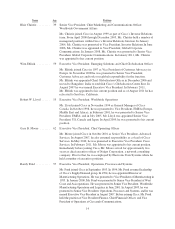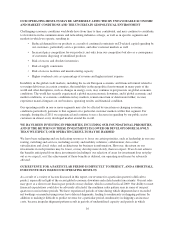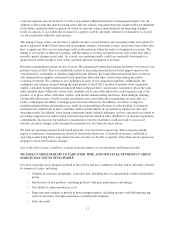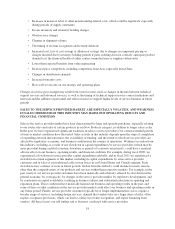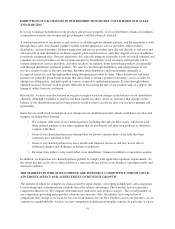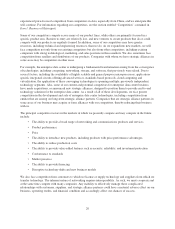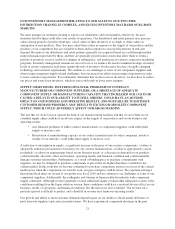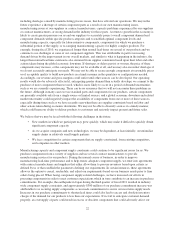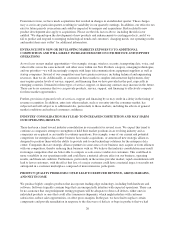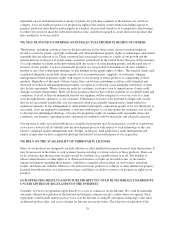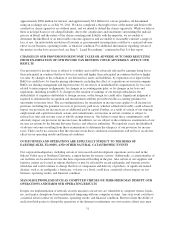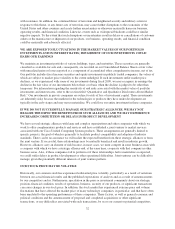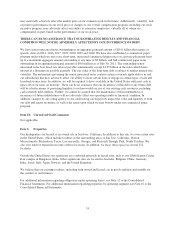Cisco 2011 Annual Report Download - page 31
Download and view the complete annual report
Please find page 31 of the 2011 Cisco annual report below. You can navigate through the pages in the report by either clicking on the pages listed below, or by using the keyword search tool below to find specific information within the annual report.gross margins. For additional information regarding our purchase commitments with contract manufacturers and
suppliers, see Note 12 to the Consolidated Financial Statements contained in this report.
Our key manufacturing facilities for Scientific-Atlanta’s products are located in Juarez, Mexico, and we may be
materially and adversely affected by any prolonged disruption in the operation of these facilities. In the fourth
quarter of fiscal 2011, we entered into an agreement to sell these manufacturing operations to one of our contract
manufacturers.
WE DEPEND UPON THE DEVELOPMENT OF NEW PRODUCTS AND ENHANCEMENTS TO
EXISTING PRODUCTS, AND IF WE FAIL TO PREDICT AND RESPOND TO EMERGING
TECHNOLOGICAL TRENDS AND CUSTOMERS’ CHANGING NEEDS, OUR OPERATING
RESULTS AND MARKET SHARE MAY SUFFER
The markets for our products are characterized by rapidly changing technology, evolving industry standards, new
product introductions, and evolving methods of building and operating networks. Our operating results depend
on our ability to develop and introduce new products into existing and emerging markets and to reduce the
production costs of existing products. We believe the industry is evolving to enable personal and business
process collaboration enabled by networked technologies. As such, many of our strategic initiatives and
investments are aimed at meeting the requirements that a network capable of multiple-party, collaborative
interaction would demand, and the investments we have made and our architectural approach are designed to
enable the increased use of the network as the platform for all forms of communications and IT. In fiscal 2009
we launched our Cisco Unified Computing System, our next-generation enterprise data center platform
architected to unite computing, network, storage access, and virtualization resources in a single system, which is
designed to address the fundamental transformation occurring in the enterprise data center. Cisco Unified
Computing System is one of several priorities on which we are focusing resources.
The process of developing new technology is complex and uncertain, and if we fail to accurately predict
customers’ changing needs and emerging technological trends our business could be harmed. We must commit
significant resources, including the investments we have been making in our priorities to developing new
products before knowing whether our investments will result in products the market will accept. In particular, if
our model of the evolution of networking to collaborative systems does not emerge as we believe it will, or if the
industry does not evolve as we believe it will, or if our strategy for addressing this evolution is not successful,
many of our strategic initiatives and investments may be of no or limited value. Furthermore, we may not execute
successfully on that vision because of errors in product planning or timing, technical hurdles that we fail to
overcome in a timely fashion, or a lack of appropriate resources. This could result in competitors providing those
solutions before we do and loss of market share, net sales, and earnings. The success of new products depends on
several factors, including proper new product definition, component costs, timely completion and introduction of
these products, differentiation of new products from those of our competitors, and market acceptance of these
products. There can be no assurance that we will successfully identify new product opportunities, develop and
bring new products to market in a timely manner, or achieve market acceptance of our products or that products
and technologies developed by others will not render our products or technologies obsolete or noncompetitive.
The products and technologies in our New Products category and those in our Other Products category that we
identify as “emerging technologies” may not prove to have the market success we anticipate, and we may not
successfully identify and invest in other emerging or new products.
CHANGES IN INDUSTRY STRUCTURE AND MARKET CONDITIONS COULD LEAD TO
CHARGES RELATED TO DISCONTINUANCES OF CERTAIN OF OUR PRODUCTS OR
BUSINESSES AND ASSET IMPAIRMENTS
In response to changes in industry and market conditions, we may be required to strategically realign our
resources and consider restructuring, disposing of, or otherwise exiting businesses. Any decision to limit
investment in or dispose of or otherwise exit businesses may result in the recording of special charges, such as
23



